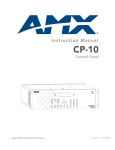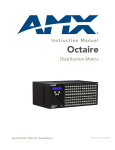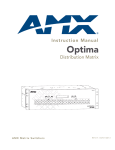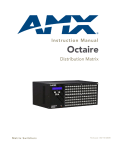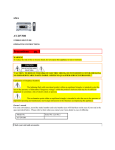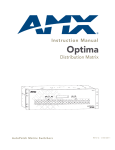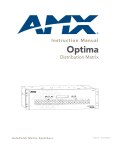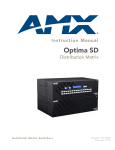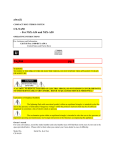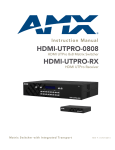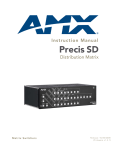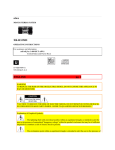Download AMX CP-15 Instruction manual
Transcript
Instruction Manual CP-15 Control Panel AutoPatch Control Panel Release: 2/14/2008 Contents Contents Introduction.........................................................................................................1 Applicability Notice ................................................................................................................. 1 Overview ................................................................................................................................. 2 Key Functions .......................................................................................................................... 2 Menus & Modes....................................................................................................................... 5 Executing Switches..............................................................................................7 Changing the Virtual Matrix ................................................................................9 Disconnecting Switches .....................................................................................10 Verifying Signal Status ......................................................................................12 Executing Presets ..............................................................................................13 Global & Local Presets........................................................................................................... 13 Executing Local Presets ......................................................................................................... 14 Defining Global Presets......................................................................................................... 15 Executing Global Presets....................................................................................................... 16 Adjusting Audio.................................................................................................17 Adjusting Output Volume...................................................................................................... 17 Muting & Un-Muting Outputs................................................................................................ 19 Adjusting Digital Input Gain .................................................................................................. 20 Locking & Unlocking..........................................................................................22 Locking the Control Panel ..................................................................................................... 22 Unlocking the Control Panel.................................................................................................. 23 Setting the Password ............................................................................................................ 23 Setup Options ...................................................................................................24 Checking the Software Version ............................................................................................. 24 Choosing the Default Virtual Matrix ...................................................................................... 25 Reloading the Configuration File........................................................................................... 26 Installing a CP-15 Remote Control Panel...........................................................27 Connecting to an AMX AutoPatch Router ............................................................................. 27 Applying Power ..................................................................................................................... 29 Rack Installation..................................................................................................................... 30 Linking Multiple Panels.......................................................................................................... 31 Completing the Installation ................................................................................................... 32 Appendix A – System Error Codes ....................................................................33 Technical Support.................................................................................................................. 34 CP-15 Instruction Manual i Contents ii CP-15 Instruction Manual Introduction Introduction Applicability Notice The information in this manual applies to the CP-15 Control Panel, which comes with many of the Optima pre-configured systems or can be ordered as a remote control panel or as part of a custom system. Pre-Configured Systems The CP-15 can be part of an Optima pre-configured system. All Optima pre-configured systems are numbered FGP46-xxxx-xxx (e.g., FGP46-0808-34B). Custom Systems The CP-15 can be ordered as an option for Optima 2 RU and 3 RU custom systems. Control Panels for Custom Systems Configuration Size Control Panel Sales # 2 RU 3 RU 8x8 FG1046-261 FG1046-240 16x16 FG1046-258 FG1046-237 16x24 FG1046-255 FG1046-234 20x20 FG1046-249 FG1046-216 24x16 FG1046-252 FG1046-231 36x4 FG1046-246 FG1046-210 Remote Control Panel The CP-15 Remote Control Panel can be ordered as a separate unit to control an Optima, Precis 500 MHz, Modula, or 8Y-3000 system. Remote Control Panels Configuration Size Control Panel Sales # 8x8 FG1090-276 CP-15 Instruction Manual 16x16 FG1090-273 16x24 FG1090-270 20x20 FG1090-267 24x16 FG1090-264 36x4 FG1090-261 1 Introduction Overview The CP-15 is used for controlling the system’s switches and system attributes. Although control panels are optional, we recommend one per system for system verification, redundant control, and troubleshooting. FIG. 1 illustrates an Optima Distribution Matrix with a CP-15 Control Panel. Other models may vary slightly in appearance. Power Indicator FIG. 1 CP-15 Control Panel on an Optima Note: AMX AutoPatch enclosures can also be controlled using BCS (Basic Control Structure) commands transmitted through an external controller; for more information, see the BCS Protocol Instruction Manual on the AMX AutoPatch CD or at www.amx.com. A CP-15 Control Panel has an LCD, a Function Key, a Control Dial, a Select Key, a Cancel Key, a Take Key, Input and Output Keys, and a Power Indicator. The Control Dial and Select Key work together for scrolling through the menus displayed on the LCD to place the system into various modes (the types of operations, e.g., Change Mode) or to access lists for control operations. Once in the desired mode, use the Input and Output Keys to select values and the Take Key to execute the operations (some modes require using the Control Dial and Select Key to select values). Key Functions Control Dial Function Key Select Key Input Keys LCD Cancel Key Take Key Output Keys FIG. 2 CP-15 Control Dial & keys Function Key The Function Key accesses the Function menu on the LCD. As the Control Dial is turned, this menu displays the various command options, e.g., Status, Disconnect, etc. The Function Key can be pressed at anytime to return the display to the Function menu. For an overview of menu options, see page 5. 2 CP-15 Instruction Manual Introduction Control Dial The Control Dial scrolls through menu options and adjusts values, such as volume. The Control Dial is used in conjunction with the Select Key to choose commands and values on the LCD. Select Key The Select Key enters a selection. In addition, the Select Key can be used to execute presets; however, the Select Key cannot execute or disconnect switches. Pressing the Take Key executes or disconnects switches. Cancel Key Pressing the Cancel Key clears an incomplete operation and returns the display to the beginning of a submenu or list. The Cancel Key cannot undo a completed operation, i.e., an operation followed by the pressing of the Take Key. If the Cancel Key flashes, an error has occurred; a flashing Cancel Key must be pressed before continuing. Take Key The Take Key functions much like the Enter Key on a computer keyboard. Pressing the Take Key instructs the system to execute or disconnect a switch. Prior to pressing the Take Key, the individual operation component(s) are selected by pressing the appropriate key(s). Input & Output Keys Input and Output Keys correspond to the input and output connections on the rear of the enclosure. These keys are used to select the inputs and outputs for routing source signals to destination devices as well as for status and audio operations. Input Keys are also used for locking and unlocking the control panel. When an Input or Output Key is pressed, the channel name displays on the LCD. Hold the key down to display the name longer. The default channel name (e.g., O_Ch:0003 for Output 3) appears unless the name has been modified in the configuration file* using XNConnect. While XNConnect allows for the creation of channel names up to 24 characters long, the CP-15 displays only the first 20 characters. FIG. 3 Example of a custom channel name * The configuration file (.xcl file) contains routing and control information for a system and is modified with XNConnect, which graphically displays the configuration file. Both the configuration file and XNConnect are on the AMX AutoPatch CD. CP-15 Instruction Manual 3 Introduction The Input and Output Keys illuminate depending on the mode (the type of operation) the CP-15 is in: Blue key – indicates that it can be selected as part of the current operation. White or flashing white key – indicates that it has been selected and that further action is required to complete the operation. A white key can also indicate routing status. When a key is flashing, it cannot be unselected and does not display label information on the LCD when pressed. Non-illuminated key – is not available for the current operation, e.g., Input Keys are unavailable when the panel is in Output Volume Mode. FIG. 4 shows various keys states while in Change Mode. Input 9 is flashing white, indicating that it was selected first. Outputs 3 and 13 are white, indicating that they have also been selected (and can be unselected). The switch from Input 9 to Outputs 3 and 13 will be executed when the Take Key is pressed. Note that Inputs 18, 19, and 20 are not available. Selected Key Flashing Available Key Selected Keys Unavailable Keys FIG. 4 Example of key states during Change Mode 4 CP-15 Instruction Manual Introduction Menus & Modes The Function menu and its submenus access the different modes and lists used to control the system. The modes are Change, Disconnect, Status, Output Volume, Mute, Input Gain, and Lock. While in a mode, the same type of operations can be performed, e.g., when in Mute Mode you can select various outputs to mute and un-mute without having to repeatedly put the CP-15 into Mute Mode. This section provides an overview of the menus and modes. Detailed information and instructions on the individual modes are provided in the remaining sections. Use the Control Dial and Select Key to navigate the Function menu, submenus, and lists. The menus are loop menus, which means that each menu returns to the first item after you scroll past the last item. The Function menu (FIG. 5) and its submenus access the following modes and lists: Change Selecting Change places the system in Change Mode. The CP-15 must be in Change Mode to execute switches. While in Change Mode, select the Input and Output(s) Keys followed by the Take Key to execute switches (see page 8). Virtual Matrix Selecting Virtual Matrix accesses the list of virtual matrices that are defined for the system. This list is used for changing the virtual matrix on which operations will be performed (see page 9). Status Selecting Status places the system in Status Mode. While in Status Mode, signal status can be verified to confirm correct routing or routing to multiple outputs without risk of accidently executing a switch (see page 12). FIG. 5 Function menu structure Disconnect Selecting Disconnect places the system in Disconnect Mode. While in Disconnect Mode, select the Input or Output Key(s) followed by the Take Key to disconnect switches (see page 10). While in Disconnect Mode, the CP-15 does not indicate the current routing of selected inputs or outputs. Setup Options Selecting Setup Options accesses the Setup Options submenu to check the Software Version, change the Default VM (Virtual Matrix), or Reload Config file (see page 24). Lock Panel Selecting Lock Panel places the panel in Lock Mode at which time the password is entered to lock the panel. Locking the CP-15 limits access which can prevent accidental switches (see page 22). Adjust Audio Selecting Adjust Audio accesses the Adjust Audio submenu. From this menu you can place the panel in Output Volume Mode, Mute/Unmute Mode, or Input Gain Mode (see page 17). Global Preset Selecting Global Preset accesses the Global Preset submenu to Define Global Presets or Execute Global Presets (see page 15). CP-15 Instruction Manual 5 Introduction Local Preset Selecting Local Preset accesses the list of local presets that can be executed (see page 14). Local Preset will only appear as an option on the Function menu if local presets have been defined in XNConnect for the selected virtual matrix. CP-15 Control Panel operations combine the following four basic tasks: To choose a mode, submenu, or list – Press the Function Key to access the Function menu. Use the Control Dial and Select Key to choose the desired mode, submenu, or list. To select inputs or outputs – Press the corresponding Input or Output Key. Selected keys will change color or flash, depending on the routing state. To select values for fields (such as virtual matrices, volume, or preset values) – Use the Control Dial and Select Key. To execute a command – Press the Take Key. 6 CP-15 Instruction Manual Executing Switches Executing Switches A switch is an active connection between an input (source) device and one or more output (destination) devices. The signals routed in a switching operation are individual signals or groups of individual signals coming through the connectors on the rear of an enclosure. Executing a preset is a quick way to execute multiple switches at a time. For information on presets, see page 13. Switches are executed on the default virtual matrix unless otherwise specified. When specifying a virtual matrix, be sure it includes all the signals you want to route. The number of the virtual matrix (VM) that operations are currently being performed on is displayed in the upper-right corner of the display. Virtual matrix definitions reside in the configuration information in each enclosure’s CPU. If you need to change the virtual matrix, see “Changing the Virtual Matrix” on page 9. If you decide to change the default virtual matrix, see page 24 for “Setup Options.” You can execute switches from the CP-15 using the steps on the following pages or by executing a local or global preset (see page 13). When an Input or Output Key is pressed, the channel name displays on the LCD. Hold the key down to display the name longer (FIG. 6). The default channel name (e.g., O_Ch:0003 for Output 3) appears unless the name has been modified in the configuration file using XNConnect (see the Help file). While XNConnect allows for the creation of channel names up to 24 characters long, the CP-15 displays only the first 20 characters. You can return to the Function menu at any time by pressing the Function Key. FIG. 6 Example of a custom channel name Note: When you put the panel in Change Mode, available keys will be blue and any unavailable ones will not be illuminated. The first blue key selected flashes white and the next key(s) selected turns white. You can toggle the non-flashing white keys between the selected (white) and unselected (blue) state before pressing the Take Key. For more information, see page 4. In an execute switch command either an input or an output can be selected first. To switch to multiple outputs, the Input Key must be selected first. With the CP-15 you can select and unselect Input and Output Keys to modify the switch as long as the keys are not flashing. Once satisfied with the switch selections, press the Take Key to execute it. For new installations, we recommend that before attaching all inputs and outputs, you perform a test switch routing Input 1 to Output 2 on the level designated by the enclosure’s “Connector Guide”. Depending on the signal type (e.g., component signals), you may need to attach multiple input and output connectors. CP-15 Instruction Manual 7 Executing Switches The example below switches Input 2 to Output 1 on the currently selected virtual matrix. To execute a switch: 1. Press the Function Key. The Function menu appears. 2. Press the Select Key to choose Change. The system is in Change Mode (the available Input and Output Keys turn blue). Current VM 8 3. Press Input Key 2. Input Key 2 flashes indicating that it is ready to switch. (Any outputs currently connected to Input 2 will turn white). 4. Press Output Key 1. Output Key 1 illuminates indicating that it is ready to accept the switch. 5. Press the Take Key. Input 2 switches to Output 1, and the keys turn blue. The panel remains in Change Mode until the Function Key is pressed. CP-15 Instruction Manual Changing the Virtual Matrix Changing the Virtual Matrix Virtual matrices are defined in XNConnect and stored in the system’s configuration file (see the XNConnect Help file). Systems usually have a virtual matrix that contains all signals, so that any input can be routed to any or all outputs. The same system may have other VMs that switch only audio signals or only video signals. Occasionally you may need to execute switches (or other operations) on a virtual matrix other than the current virtual matrix. Changing the virtual matrix does not change the default virtual matrix. The system will revert to switching on the default virtual matrix when the power is cycled. For information on changing the default virtual matrix, see page 25. The directions below give the steps for changing from routing signals on Virtual Matrix 0 “Audio/Video” to routing on Virtual Matrix 2 “Audio, Stereo.” To change the virtual matrix: 1. Press the Function Key. The Function menu appears. 2. Locate Virtual Matrix by scrolling with the Control Dial. 3. Press the Select Key. The V. Matrix list appears. Current VM 4. Scroll to 2:Audio, Stereo. 5. Press the Select Key to enter your selection. The display returns to the top of the V. Matrix submenu. VM 2 becomes the new virtual matrix used for all operations. 6. Press the Function Key to return to the Function menu. The system is ready to make changes on Virtual Matrix 2 “Audio, Stereo.” The system will remain on Virtual Matrix 2 for all operations until the virtual matrix is changed or the power is cycled. CP-15 Instruction Manual 9 Disconnecting Switches Disconnecting Switches Disconnecting a switch deactivates the connection between an input (source) and one or more output (destination) devices. Disconnecting an input disconnects all outputs currently receiving that source signal. An output can only be connected to one input; therefore, disconnecting an output will only disconnect the connection between the output and the input that is routed to it. You can disconnect a switch by selecting either inputs or outputs from the CP-15 Control Panel. Inputs and outputs can be selected in the same disconnect command. Although switches can be disconnected when in panel is in Change Mode, the advantage of using the Disconnect Mode is that it can be used to quickly disconnect multiple outputs receiving a signal from the same input (by disconnecting the input) or from different inputs (by disconnecting the outputs). If you need to change the virtual matrix, see “Changing the Virtual Matrix” on page 9. You can return to the Function menu at any time by pressing the Function Key. Note: When you put the panel in Disconnect Mode, available keys will be blue and any unavailable ones will not be illuminated. When you select a blue key, it turns white. You can toggle the keys between the selected (white) and unselected (blue) state before pressing the Take Key. For more information, see page 4. Once the CP-15 is in Disconnect Mode, inputs and outputs can be selected and unselected by pressing the corresponding Input and Output Keys. The disconnect command is not executed until the Take Key is pressed. While in Disconnect Mode, the CP-15 will not show current routing for the inputs and outputs that are selected. Caution: Disconnecting an input disconnects all outputs receiving that source signal even if a specific output(s) is selected at the same time. The example below disconnects Inputs 1 and 3 and all outputs connected to them as well as Output 9. To disconnect inputs and outputs: 10 1. Press the Function Key. The Function menu appears. 2. Locate Disconnect by scrolling with the Control Dial. CP-15 Instruction Manual Disconnecting Switches 3. Press the Select Key. The system is in Disconnect Mode (all the available Input and Output Keys turn blue). Current VM 4. Press Input Keys 1 and 3 and Output Key 9. The keys turn white indicating that they are selected. 5. Press the Take Key. Inputs 1 and 3 (and all outputs connected to them) and Output 9 are disconnected as soon as the Take Key is pressed, and the keys turn blue. 6. Execute additional disconnects. Or Press the Function Key to return to the Function menu. CP-15 Instruction Manual 11 Verifying Signal Status Verifying Signal Status Signal status can be verified to confirm that a switch has executed properly or to confirm correct routing to multiple outputs (destinations). Input status and output status both function on the CP-15 Control Panel. An output can only be connected to one input (source); therefore, verifying the status of an output will illuminate only the one input it is currently connected to. Verifying an input will illuminate all outputs currently receiving the input’s signal. The advantage of using Status Mode (instead of Change Mode, which also indicates routing) is that status is verified without the risk of inadvertently executing unwanted switches. Once the CP-15 is in Status Mode, inputs and outputs can be selected by pressing the corresponding Input and Output Keys without changing the routing state. The CP-15 stays in Status Mode until the Function Key is pressed. If you need to change the virtual matrix, see “Changing the Virtual Matrix” on page 9. You can return to the Function menu at any time by pressing the Function Key. To verify the status of a signal: 12 1. Press the Function Key. The Function menu appears. 2. Locate Status by scrolling with the Control Dial. 3. Press the Select Key. The system is in Status Mode (all available Input and Output Keys turn blue). 4. Press the Input Key that corresponds to the input you want to check. The selected Input Key turns white, and any Output Keys receiving the input signal also turn white. Or Press the Output Key that corresponds to the output you want to check. The selected Output Key turns white, and any Input Key routed to it also turns white. 5. Select another signal to verify. Or Press the Function Key to return to the Function menu. CP-15 Instruction Manual Executing Presets Executing Presets Global & Local Presets Global and local presets are predefined sets of switches that can easily be executed. Local Presets A local preset is a predetermined set of switches on a particular virtual matrix that are routed simultaneously. They are stored in each enclosure’s configuration file and can be executed at any time. Local Preset will not appear as a submenu option in the Function menu if local presets have not already been defined. They will also not appear if the system is on a virtual matrix that does not have local presets. Local presets are not programmed (defined) at the factory. To program them, use XNConnect (see the XNConnect Help file) or contact your AMX representative (for contact information, see page 34). Once the local presets have been defined as part of the configuration file, the new file must be loaded to the system’s CPU and reloaded to the CP-15 (see page 26). Global Preset A global preset is a snapshot of an entire system’s state which enables that system state to be replicated at a later time. The system state includes all current signal routings (regardless of the number of virtual matrices involved) and any digital gain and/or volume settings. Before defining a Global Preset, route the system to the desired state (including audio settings if applicable). A global preset number is assigned to a system state during runtime using the CP-15 Control Panel (or BCS commands) and is stored in the switcher’s non-volatile memory. That system state can then be restored at any time by selecting the assigned global preset number. Note: Global presets cannot be defined (created) in XNConnect. The CP-15 can store up to 64 global presets. Since the panel can be used to operate different types of matrix switchers, check the product documentation for any limitations to the number of supported global presets. We strongly recommend keeping track of the number used and the system’s routing state for each global preset. If another system state is assigned a previously used number, the former state will be automatically overwritten. Caution: If the system is reconfigured, global presets may be lost, depending on the method used to load the new configuration file (see the XNConnect Help file). CP-15 Instruction Manual 13 Executing Presets Executing Local Presets Make sure the CP-15 is on the virtual matrix where the local preset resides. If no local presets have been defined for the selected VM, the Local Preset submenu option will not be available on the Function menu. Note: Executing a local preset does not change any system routings that are not part of the preset. The example below executes Local Preset 3 “Discon Conf Rm B” on VM 0. To execute a local preset: 1. Press the Function Key. The Function menu appears. 2. Locate Local Preset by scrolling with the Control Dial. 3. Press the Select Key. The Local Preset list appears. Current VM 14 4. Scroll to Local Preset 3:Discon Conf Rm B. 5. Press either the Select Key or the Take Key. Local Preset 3 “Discon Conf Rm B” is executed. 6. Press the Function Key to return to the Function menu. Or Execute another local preset. CP-15 Instruction Manual Executing Presets Defining Global Presets The example below defines Global Preset 3, and the example on the next page executes Global Preset 3. Important: Wait approximately ten seconds for the system to permanently store the global preset setting before performing another operation. To define a global preset: 1. Route the system to the desired state. 2. Press the Function Key. The Function menu appears. 3. Locate Global Preset by scrolling with the Control Dial. 4. Press the Select Key. The Global Preset submenu appears. 5. Press the Select Key again to choose Define Global. The Define Global list appears. 6. Scroll to Global Preset 3. 7. Press either the Select Key or the Take Key. 8. Wait approximately ten seconds for the system to store the global preset setting. The current routing state can now be recalled as Global Preset 3, and the system returns to the Global Preset submenu. 9. Press the Function Key to return to the Function menu. CP-15 Instruction Manual 15 Executing Presets Executing Global Presets To execute a global preset: 1. Press the Function Key. The Function menu appears. 2. Locate Global Preset by scrolling with the Control Dial. 3. Press the Select Key. The Global Preset submenu appears. 4. Scroll to Execute Global. Press the Select Key. The Execute Global Preset list appears. 5. Scroll to Global Preset 3. 6. Press either the Select Key or the Take Key. Global Preset 3 is executed. The system returns to the Global Preset submenu. 7. Press the Function Key to return to the Function menu. Note: Status is not invalidated by global presets. 16 CP-15 Instruction Manual Adjusting Audio Adjusting Audio Some audio boards in AMX AutoPatch Distribution Matrices offer optional volume control and digital input gain adjustment features. If your system contains these boards, output volume or digital input gain can be adjusted using either the CP-15 Control Panel or BCS commands sent through a serial controller. For more information on audio adjustment using BCS commands, see the BCS Protocol Instruction Manual. The Adjust Volume Screen displays the current volume setting and the range available for the specific audio output board that has been selected for adjustment. The Adjust Input Gain Screen displays the current gain setting and the range available for the specific audio input board that has been selected for adjustment. When volume or digital input gain is adjusted for a device on one virtual matrix, the adjustment remains in effect for that device on all virtual matrices switching audio signals. Important: For AMX AutoPatch systems, the total through-system gain (the amount of input gain plus the amount of output gain) specified for any input/output routing path cannot exceed 10 dBr. If you enter a volume (gain) command that exceeds 10 dBr when it is combined with the gain of an input, the command will be accepted (and will be indicated in status results) but will not result in an audible difference of more than 10 dBr. When the panel is placed in any of the Audio Modes, available keys will be blue and any unavailable ones will not be illuminated. When you select a blue key, it turns white indicating that it is ready for the audio adjustment. You can adjust output volume, mute outputs, and adjust input gain from the CP-15 Control Panel using the steps on the following pages. You can return to the Function menu at any time by pressing the Function Key. Adjusting Output Volume If your system has volume control, adjustments (within the volume range for the specific audio output board) can be made at any time during time during normal operation. When audio is adjusted for a device on one virtual matrix, the adjustment remains in effect for that device on all virtual matrices switching audio signals. To adjust the volume: 1. Press the Function Key. The Function menu appears. 2. Locate Adjust Audio by scrolling with the Control Dial. CP-15 Instruction Manual 17 Adjusting Audio 3. Press the Select Key. The Adjust Audio submenu appears. 4. Press the Select Key again to choose Output Volume. The CP-15 is in Output Volume Mode (all Input Keys are turned off, and the available Output Keys turn blue). Current VM 5. Press the Output Key that corresponds to the output to be adjusted. The Adjust Volume Screen appears, displaying the volume range of the audio board and the current volume setting for the selected output. Current Volume Setting Volume Range 6. Adjust the volume by turning the Control Dial. The volume audibly adjusts as you turn the Control Dial. 7. Select another output to adjust. Or Press the Cancel Key to return to the Adjust Audio submenu. Or Press the Function Key to return to the Function menu. Note: If the selected output is muted, “Muted” displays as the current setting. Turning the Control Dial will un-mute a muted output and adjust the Volume. To reapply mute, see page 19. FIG. 7 Example of muted output in Output Volume Mode 18 CP-15 Instruction Manual Adjusting Audio Muting & Un-Muting Outputs This feature will work only if the system supports volume control. Note: The mute/un-mute option applies to output volume only and is not available for input gain. To mute an output: 1. Press the Function Key. The Function menu appears. 2. Locate Adjust Audio by scrolling with the Control Dial. 3. Press the Select Key to enter the selection. The Adjust Audio submenu appears. 4. Scroll to Mute/Unmute. 5. Press the Select Key. The system is in Mute Mode (all Input Keys are turned off, and the available Output Keys turn blue), and any muted Output Keys turn white. 6. Press the Output Key that corresponds to the output to be muted. The output is muted, and the Output Key turns white. 7. Select another output to mute. Or Press the Cancel Key to return to the Adjust Audio submenu. Or Press the Function Key to return to the Function menu. To un-mute an output while in Mute Mode: 1. Press the muted (white) Output Key. The output is un-muted, and the Output Key turns blue. CP-15 Instruction Manual 19 Adjusting Audio Adjusting Digital Input Gain If your system has digital input gain control, adjustments (within the gain range for the specific audio input board) can be made at any time during normal operation. When audio is adjusted for a device on one virtual matrix, the adjustment remains in effect for that device on all virtual matrices switching audio signals. Caution: We strongly recommend that digital input gain adjustments be made only by a qualified dealer or installer. Purpose & Uses of Input Gain The purpose of controlling input gain (the nominal level of the signal from the source device) is to allow source signals of various amplitudes to be equalized before they are routed and the volume is adjusted. Equalizing source levels provides a consistent reference for volume adjustments and eliminates jumps when routing a new source to a destination. Typical uses for input gain adjustment include switching consumer and professional grade audio equipment (whose levels can vary noticeably) in the same matrix switcher. Input gain adjustment is also used for equalizing amplitudes between balanced and unbalanced source inputs. To adjust input gain (including adjusting input gain to equalize input levels): 20 1. If adjusting input gain to equalize input levels – Route a source (input) to the desired destination (output). 2. Press the Function Key. The Function menu appears. 3. Locate Adjust Audio by scrolling with the Control Dial. 4. Press the Select Key to enter the selection. The Adjust Audio submenu appears. 5. Scroll to Input Gain. 6. Press the Select Key. The system is in Input Gain Mode (the available Input Keys turn blue, and all Output Keys are turned off). CP-15 Instruction Manual Adjusting Audio 7. Press the Input Key that corresponds to the input to be adjusted. The Adjust Input Gain Screen appears, displaying the gain range of the audio board and the current gain setting. Current Gain Setting Gain Range 8. Adjust the input gain by turning the Control Dial. The gain audibly adjusts as you turn the Control Dial. 9. If adjusting input gain to equalize input levels – Repeat Steps 7 and 8 for all sources that will be routed to the same destination. Or If adjusting input gain for a single input – Repeat Steps 7 and 8 for the desired input. 10. Press the Cancel Key to return to the Adjust Audio submenu. Or Press the Function Key to return to the Function menu. CP-15 Instruction Manual 21 Locking & Unlocking Locking & Unlocking The CP-15 can be locked by entering a sequence of Input Keys. Locking the panel prohibits access to the system and can prevent accidental switching. The password can be any combination of the first eight Input Keys. The factory default password is the first five Input Keys (1 2 3 4 5). For setting the password, see page 23. While the control panel is locked, BCS commands still work; however, they cannot be used to unlock the panel. The panel remains locked if the power is cycled. If the password is lost while the system is locked, contact technical support (for contact information, see page 34). Locking the Control Panel The following example uses the default password of “1 2 3 4 5” entered using the first five Input Keys. If you enter the wrong password while attempting to lock the control panel, an invalid password message appears and the Cancel Key flashes. Press the Cancel Key to clear the error and enter the correct password. Note: For security purposes, the Input Keys do not turn white when pressed while locking and unlocking the panel. To lock the control panel: 22 1. Press the Function Key. The Function menu appears. 2. Locate Lock Panel by scrolling with the Control Dial. 3. Press the Select Key. The system is in Lock Mode (the Input and Output Keys turn blue). 4. Press the Input Keys in the following order: 1, 2, 3, 4, 5. The panel is locked, and all Input and Output Keys turn off. CP-15 Instruction Manual Locking & Unlocking Unlocking the Control Panel When the panel is locked and you press any key, the Unlock Panel Screen appears and you have ten (10) seconds to enter the password, or the control panel remains locked. If you wait longer than 10 seconds, press any key again before entering the password. If you enter the wrong password while attempting to unlock the control panel, an invalid password message appears and the Cancel Key flashes. Press the Cancel Key to clear the error and enter the correct password. The following example uses the default password of “1 2 3 4 5” entered using the first five Input Keys. To unlock the control panel: 1. Press any key. The Unlock Panel Screen appears, and the Input and Output Keys turn blue. You must enter the password within ten (10) seconds. 2. Press the Input Keys in the following order: 1, 2, 3, 4, 5. The panel unlocks and returns to the Function menu. Setting the Password The password can be set in the configuration file using XNConnect. The password can be any combination of the first eight Input Keys (keys can be used multiple times). To set the password and load it to the CP-15: 1. Connect the enclosure to a PC running XNConnect (for more information, see the XNConnect Help file). 2. Open the configuration file in XNConnect. 3. Select the Hardware tab. 4. Right click the CP-15 Control Panel and select Set Password from the menu. The Set Control Panel Password dialog box opens. 5. Enter a number that corresponds to one of the first eight Input Keys into each field. 6. Check the box for Configure Password Immediately, and click OK. Or Click OK, and select Configure All Passwords from the Configure menu (under Configure Special – Hardware). 7. Save the modified configuration file. CP-15 Instruction Manual 23 Setup Options Setup Options Using the Setup Options submenu, you can check the software version information, set the default virtual matrix, and reload the configuration file. Checking the Software Version Software Version Screen The Software Version Screen provides the following information: Driver – control panel’s firmware version Built – date the control panel’s software was built Host – software version of the initial operating system (IOS) for the control panel XNet ID – control panel’s XNNet device number FP Link baud 115200 – indicates a front control panel and the baud rate Or Bridge – indicates a remote control panel and the version of its communication link to the enclosure’s CPU Use the following steps to check the software version information for the CP-15 Control Panel. To check the software version information: 24 1. Press the Function Key. The Function menu appears. 2. Locate Setup Options by scrolling with the Control Dial. 3. Press the Select Key. The Setup Options submenu appears. CP-15 Instruction Manual Setup Options 4. Press the Select Key again to choose Software Version. The Software Version Screen appears. Version Number 5. Scroll to see additional Software Version information. 6. Press the Cancel Key to return to the Setup Options submenu. Or Press the Function Key to return to the Function menu. Choosing the Default Virtual Matrix You have the option of changing the factory default virtual matrix for your system. When you choose a new default virtual matrix, the system will revert to that virtual matrix each time the system is powered up even if you changed the virtual matrix using the V. Matrix list during normal operation. The power must be cycled before the default virtual matrix changes are implemented. If you want to immediately switch on the default matrix, either change the current virtual matrix (see page 9) or cycle the power. If changes are made to the configuration file, check to be sure that the system is using the correct default virtual matrix. The example below selects Virtual Matrix 2 “Audio, Stereo” as the default virtual matrix. To choose the default virtual matrix: 1. Press the Function Key. The Function menu appears. 2. Locate Setup Options by scrolling with the Control Dial. 3. Press the Select Key. The Setup Options submenu appears. 4. Scroll to Default VM. Press the Select Key. The Default VM list appears. Current Default VM 5. Scroll to 2:Audio, Stereo. 6. Press the Select Key. The display returns to the top of the Setup Options submenu, and Virtual Matrix 2 “Audio, Stereo” is the default matrix. CP-15 Instruction Manual 25 Setup Options To immediately perform operations on the new default virtual matrix: 1. Change the virtual matrix (see page 9). Or Cycle the power. Reloading the Configuration File Important: This section does not apply to setting a new password; for information on setting a password in XNConnect, see page 23. The configuration file contains system information that is loaded to the CPU in the matrix switcher. The CP-15 Control Panel automatically references this information during all of the control operations. If adding a CP-15 remote to an existing system, the configuration file will need to be reloaded to the CP-15 using the directions on page 26. If you need to modify the configuration file for a system with a CP-15, be sure to use XNConnect Version 2.4.0 or greater. When changes are made to the configuration file in XNConnect (e.g., customizing channel names or creating presets), the modified configuration file must be loaded to the system’s CPU using one of the Configure menu options (see the XNConnect Help file). If the configuration file was loaded to the system’s CPU using any of following options, the CP-15 will need to reload the file. Configure / Configure Special – Virtual Matrix / any of the three choices Configure / Configure Special – Hardware / Configure All Device Names Configure Special (from the enclosure’s shortcut menu) / Configure Virtual Matrices The file can be reloaded by following the directions below or by right-clicking the CP-15 icon in XNConnect and selecting Configure from the shortcut menu. To reload the configuration file: 26 1. Press the Function Key. The Function menu appears. 2. Locate Setup Options by scrolling with the Control Dial. 3. Press the Select Key. The Setup Options submenu appears. 4. Scroll to Reload Config. 5. Press the Select Key. The display returns to the top of the Setup Options submenu, and the configuration file reloads from the CPU to the CP-15. (Depending on the file size, reloading may take a few moments.) CP-15 Instruction Manual Installing a CP-15 Remote Control Panel Installing a CP-15 Remote Control Panel This section covers rack installation for the CP-15 Remote Panel, as well as instructions for linking multiple panels. When the installation is complete, perform a test switch to make sure the system is working properly (see page 32). General Specifications Parameter Value Cable for XNNet Communications Two-conductor, 20 AWG, 7/28 strand cable with a drain wire or shield, such as Alpha 2412C (customer supplied) Power +24 volt DC @ ≥600 mA Distance: 1000 ft. (304.8 m) total, including linked panels Humidity 0 to 90% non-condensing Dimensions 0.97 in. (2.46 cm) depth 19.0 in. (48.26 cm) width with mounting ears 3.50 in. (8.89 cm) height, 2 RU Weight Approximately 1 lb 10 oz (0.74 kg) per panel Rear View Service connector – do not use as a point of control Power connectors Comm Link connectors FIG. 8 Rear view of CP-15 Remote Panel Caution: The Service connector is not to be used as a point of control. It should be used for service only as directed by AMX technical support. Connecting to an AMX AutoPatch Router Communication Cable Requirements Two-conductor, 20 AWG, 7/28 strand cable with a drain wire or shield, such as Alpha 2412C (customer supplied) Maximum length of cable: 1,000 ft. (304 m) total, including linked panels CP-15 Instruction Manual 27 Installing a CP-15 Remote Control Panel To connect a CP-15 Remote to an AMX AutoPatch Matrix Switcher: 1. On the CP-15 Remote, unplug one of the Comm Link connectors. 2. Loosen the two outer screws on the connector. 3. Insert the two wires of the XNNet cable into the two outer slots of the connector, leaving the center slot empty (FIG. 9). Note that either wire can be inserted into either of the outer slots. XNNet Link Cable to the Router FIG. 9 Insert the wires into a Comm Link 4. Tighten both screws and plug the connector back into the Comm Link. 5. On the router’s CPU, unplug the XNNet connector (for XNNet connector location, see the matrix switcher documentation). 6. Loosen the two outer screws on the connector. 7. Insert the two wires from the CP-15 Remote into the two outer slots of the connector from the CPU, leaving the center slot empty (FIG. 10). Note that either wire can be inserted into either of the outer slots. 8. Tighten the screws and plug the connector back into the CPU. FIG. 10 Insert the wires into the XNNet connector on the CPU (Optima shown) 28 CP-15 Instruction Manual Installing a CP-15 Remote Control Panel Applying Power Power Requirements +24 volt DC with at least 600 mA per panel Important: Always use a UL approved power source. Be sure to check the power source documentation for information specific to that power source. The instructions below are for using an AMX AutoPatch wall transformer. To apply power to the CP-15 Remote using the wall transformer: 1. Insert the power plug from the transformer into the power jack on the CP-15 Remote (FIG. 11). 2. Place the CP-15 Remote in a rack or other permanent installation location before plugging the transformer into the power source. Power Jack Terminal Block Connector FIG. 11 Insert the plug into the power jack CP-15 Instruction Manual 29 Installing a CP-15 Remote Control Panel Rack Installation CP-15 Remote Panels are designed to fit in a standard EIA 19 in. (48.26 cm) rack. Once the CP-15 Remote is wired, follow the rack installation instructions below. If linking multiple panels, see “Linking Multiple Panels” on page 31 before installing the panels in a rack. Note: The optimum viewing angle for the screen is eye level. To install the CP-15 Remote in a rack: 1. Insert the wired panel through the rear of the rack. 2. Attach with front-mounting screws to hold it firmly in place (FIG. 12), repeating for each panel in a multi-panel system. Tip: You may find it easier to install the top panel first and move down from there. FIG. 12 Place in rack and fasten with mounting screws 3. Apply power to the panel(s). 4. Wait briefly for the system to establish communication with the remote panel. Perform a test switch to make sure the system is working properly (see “Completing the Installation” on page 32). If the system is not working properly, check all system connections and retry the test switch before contacting technical support (for contact information, see page 34). Note: If the remote control panel was not part of the original system, you will need to load the configuration file to the CP-15 Remote; for instructions, see page 26. 30 CP-15 Instruction Manual Installing a CP-15 Remote Control Panel Linking Multiple Panels CP-15 Remote Panels can be linked together in a daisy chain to create multiple control points for a single system. Note: If any of the linked CP-15 remote panels were not part of the original system, the current configuration file must be uploaded to the remote; for instructions, see page 26. Cable Requirements Two-conductor, 20 AWG, 7/28 strand cable with a drain wire or shield, such as Alpha 2412C (customer supplied) Total distance of the cable runs cannot exceed 1,000 ft. (304.8 m) Power Requirements +24 volt DC with at least 600 mA per panel Important: Always use a UL approved power source. Be sure to check the power source documentation for information specific to that power source. The instructions below are for linking CP-15 Remote Panels using individual AMX AutoPatch wall transformers for power. If using a different transformer or a centralized power source, note the acceptable power requirements (see above) and see the transformer or power source documentation for wiring information. For assistance with other wiring, contact technical support (for contact information, see page 34). To link CP-15 Remote Panels to each other: 1. Connect the first panel to the AMX AutoPatch Router using one of the Comm Links (for instructions, see page 28). 2. Attach an XNNet link cable to the other Comm Link on the first panel (follow the same procedure used when connecting to the AMX AutoPatch Router). 3. Attach the other end of the XNNet link cable to a Comm Link on the next panel. XNNet Link Cable to Router XNNet Link Cable XNNet Link Cable FIG. 13 Comm links connected in a daisy chain 4. Repeat Steps 2 and 3 for any additional panels to be linked. CP-15 Instruction Manual 31 Installing a CP-15 Remote Control Panel 5. Insert the power plug from each of the AMX AutoPatch transformers into the power jack on each of the CP-15 remote panels. 6. Place the panels in rack(s) or in other permanent installation locations. 7. Plug the wall transformers into the power sources. We recommend completing the installation by performing a test switch to make sure the system is working properly (see below). Note: If experiencing difficulties, insert a 120 ohm resistor in the outer contacts of the unused Comm Link on the last remote of a large daisy chain and tighten the screws. If problems persist, contact technical support (see page 34). Completing the Installation We recommend completing the installation by executing a test switch routing Input 1 to Output 2 on the level designated by the enclosure’s “Connector Guide.” To execute a test switch: 1. Press the Function Key. The Function menu appears. 2. Press the Select Key to choose Change. 3. Press Input Key 2. Input Key 2 flashes indicating that it is ready to switch. 4. Press Output Key 1. Output Key 1 illuminates indicating that it is ready to accept the switch 5. Press the Take Key. Input 2 switches to Output 1, and the keys turn blue. If the test switch does not execute correctly, check all system connections and retry the test switch before contacting technical support, (for contact information, see page 34). 32 CP-15 Instruction Manual Appendix A – System Error Codes Appendix A – System Error Codes This appendix provides an overview of common error codes that can appear on a CP-15 Control Panel. The table below lists the error code, the name of the code, the meaning of the code, and some basic troubleshooting strategies (additional troubleshooting strategies are included on page 34). The codes in the table are not intended to be comprehensive. If an error code appears that is not listed, note the specific number and contact technical support, (for contact information, see page 34). The first letter of the error code indicates the following: E = Error W = Warning A = Alarm* (requires immediate attention) I = Information* * Because these codes very rarely appear, they are not included in the table. Error Code E01000A Name Enclosure timeout error Meaning Troubleshooting Strategies One or more of the enclosures in a • Resend the command. multi-enclosure system did not • Check the Status LED on the rear of each acknowledge a control operation enclosure. If any are red, contact tech command. support. • Check the power indicators. • Check the link connections between enclosures. EFF8002 Enclosure timeout error The operation was not completed before the timer expired. • Resend the command. • Check the power indicators. • Check the link connections in multi-enclosure systems. • Check that the virtual matrix used in the command was valid. E01DFFF Audio request A volume or gain request was error made on a virtual matrix that does not switch audio. • Resend the command on a virtual matrix that includes audio. W010005 Sync timeout warning • Resend the command. The system did not receive the vertical interval sync signal. Note that the switch occurred, but not at the sync interval. • Check the sync cable connections. • Check the HyperTerminal splash screen to verify that sync is enabled (see the Vertical Interval Sync Board supplement). • Check that the sync signal from the generator is being received by the vertical interval sync board. • Power the system down and check sync board alignment and seating. CP-15 Instruction Manual 33 Appendix A – System Error Codes Troubleshooting Error codes can appear either on the control panel or in a terminal emulation program, such as HyperTerminal. When you are using a control panel, one of the most common troubleshooting strategies is to resend the command to see if the error was simply a timeout error. When you are using BCS (Basic Control Structure) commands, one common troubleshooting strategy is to enter the command again. Often the command has simply been entered incorrectly (e.g., omitting an output in a Change command). In other cases, the command has specified a value that is not valid (e.g., entering a decibel value in an adjust volume command that is outside the volume range for the audio board). Technical Support Before contacting technical support with a question, please consult this manual. If you still have questions, contact your AMX representative or technical support. Have your system’s serial number ready. The system’s serial number is normally located on the rear of the enclosure; if not, remove the left expansion plate above the power receptacle and look inside the inclosure to the left. We recommend recording your system’s serial number in an easily accessible location. AMX Contact Information 3000 Research Drive, Richardson, TX 75082 800.222.0193 469.624.8000 Fax 469.624.7153 Technical Support 800.932.6993 www.amx.com 34 CP-15 Instruction Manual All rights reserved. AMX and the AMX logo are registered trademarks of AMX. AMX reserves the right to alter specifications without notice at any time. ©. 2/08 2008 AMX It’s Your World - Take Control™ 3000 RESEARCH DRIVE, RICHARDSON, TX 75082 USA • 800.222.0193 • 469.624.8000 • 469-624-7153 fax • 800.932.6993 technical support • www.amx.com







































